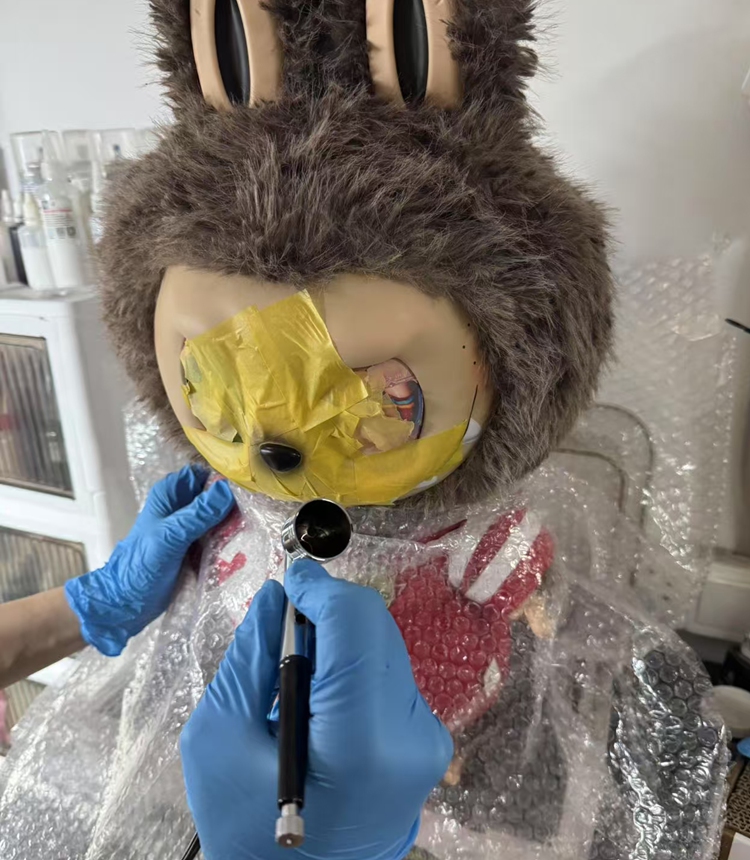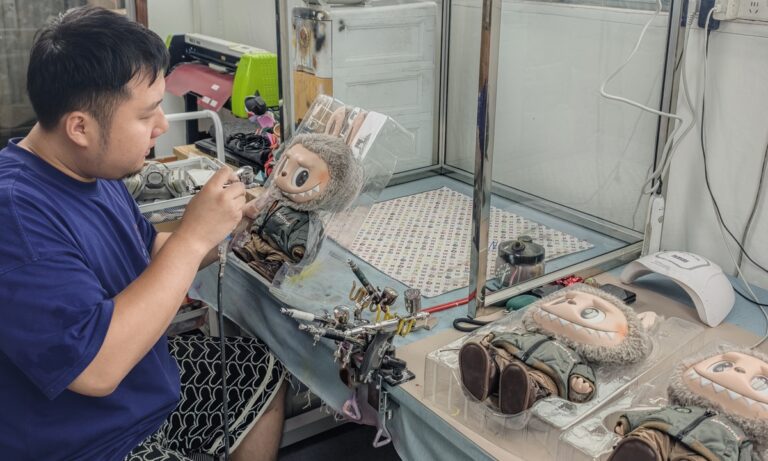Toy restorer Ha Teman inspects a Labubu plush toy at his workshop in Shanghai. Photo: Courtesy of Ha Teman
Inside a workshop in Shanghai, 29-year-old Ha Teman (pseudonym) delicately maneuvers a spray gun across the surface of a Labubu doll.
Each sweep of paint helps conceal the scratches and dull patches that time and mishandling have etched into the popular figure.
For Ha and a growing number of “toy doctors” in China, restoring collectible toys like Labubu is both a profession and a personal interest.
Labubu, the nine-toothed, punk-cute creature from Chinese trendy toy company Pop Mart’s “The Monsters” series, has become more than just a toy.
According to the Xinhua News Agency, its IP generated over 3 billion yuan ($420 million) in global revenue in 2024, a 726.6 percent increase from the previous year, making it Pop Mart’s most successful product line to date.
Demand has surged to the point that limited edition Labubus are nearly impossible to find. One human-sized, mint-green version of the toy sold for a record 1.08 million yuan at a Beijing auction in June.
As Labubu transitions from pop culture fad to highly coveted collectible, some owners are not only seeking replacements for their damaged toys, but also salvation.
Instead of discarding those faded or damaged figures, many collectors are turning to “toy doctors” or toy restorers, paying to breathe new life into their beloved companions.
For some, it’s less about monetary value and more about preserving memories.
Memory keeper
On China’s lifestyle-sharing platform Xiaohongshu, or rednote, searches for “Labubu restorers” yield a stream of posts – from toy owners seeking help to DIY attempts and detailed restoration case studies shared by seasoned artisans.
“Restoring a toy with a story is like mending a part of someone’s life,” Chen Qi (pseudonym), a Gen Z toy restorer and longtime toy collector based in Shanghai, told the Global Times.
Chen began fixing toys two years ago, including a year of experience working on Labubu figures.
The clientele is diverse, ranging from casual players and individual collectors to businesses and corporate collectors, she told the Global Times.
Among the most common damages she sees are chipped paint and scratches.
The most challenging for her, she said, are facial features — rosy cheeks, delicate lips and fine cosmetic details. She gave the example of fixing a simple case of chipped paint.
The first step is to mask off surrounding areas to prevent further damage. Next, she matches the color of the chipped paint and fills in the affected area with putty. Using sandpaper of varying grits, she smooths the surface little by little. Then the area is airbrushed with color, followed by a final coat of protective varnish.
For many collectors, restoring a Labubu toy is less about aesthetics and more about emotion.
As a longtime toy enthusiast, Chen said that with each restoration, she better understands her clients’ motivations.
“When someone is willing to pay several times the original price to fix a toy,” she said.
“What they’re really trying to preserve isn’t the object itself, but the irreplaceable emotional memories attached to it.”

Yang Fan repairs a Labubu plush toy. Photo: Courtesy of Yang Fan
Growing market
Ha, who has worked in toy restoration for seven years, has recently seen a spike in Labubu repair requests.
“We’re running out of space to store all these ‘little patients,'” he said.
In his experience, repairs of toys tend to fall into two main categories: Structural damage, like broken limbs or dislodged joints, and surface damage, such as scratches or chipped paint, being most common. So restoration fees vary accordingly.
For example, most of the Labubu repairs he handles involve paint scuffs, with each blemish typically costing around 150 yuan to fix.
Restoring designer toys isn’t always possible.
“When some materials are beyond repair, and we generally have to decline those requests,” said Ha.
For Chen, restoration pricing also depends on the complexity of the work.
“If the item has a particularly high market value, I may adjust the fee accordingly,” she said. “I’m responsible for the result, and that means taking on greater financial risk.”
Yang Fan, another restorer with five years of experience in restoring toys, told the Global Times that because the restoration process is so intricate, the cost of repairing a Labubu figure is often not “friendly” to the average customer.
“We usually price repairs based on their level of difficulty,” he said.
“What might seem like a simple touch-up to most people involves a complex, multi-step process if we want to achieve a perfect result.”
Despite efforts to explain the detailed labor involved, it’s difficult to base repair costs solely on the toy’s original market value, added Yang.
He emphasized that customers will be informed in advance if a figure cannot be repaired or if costs might exceed expectations.
As the collectible toy market continues to develop in China, so too does the demand for professional repair services.
However, with the field still in its infancy, standards for pricing and quality remain inconsistent.
Ha noted that the business always depends on trends in IP-driven collectibles.
“As long as toy culture continues to grow, the demand for restoration won’t disappear,” he said. “The focus may simply shift from current popular IPs to emerging ones.”
“Right now, there’s a lack of consistency in service standards and pricing across the market, so consumers need to be cautious,” Chen said.
Still, she remains optimistic about the industry’s future.
“As the market matures,” she added, “professionalization and standardization are inevitable trends.”
“Restoration is more than just a technical skill; it’s a heartfelt exchange,” Chen said.


